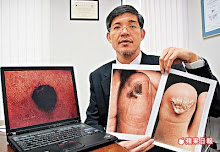Dr Edwin Poon

Dr Edwin Poon graduated from University College in London with a Science and Medical Degree. He furthered his training in the UK and in Hong Kong and has special interests in Smoking Cessation, Allergy and Immunotherapy, Lung Cancer screening and Sleep disordered breathing. He has published in many international Medical Journals and was part of the team that devised the SARS treatment protocol that was adopted by the WHO. He has advised the Hospital Authority’s Working Group on Doctors’ hours, Central Training Advisory Committee, the Hong Kong East Smoking Cessation and Counselling Centre, the Hong Kong Amateur Swimming Association and numerous Private Hospital advisory committees.
Professional Qualifications
FCCP : 2007
FHKCP (Respiratory Medicine) : 2002
FHKAM (Medicine) : 2002
MRCP (UK) : 1998
MBBS (Lond) : 1994
BSc (Lond) : 1991
Special Interests
Immunotherapy in respiratory allergy, rhinitis and asthma
Sleep disordered breathing
Lung cancer screening and diagnosis
Smoking cessation
Air pollution
Hypoxic training
Medical conditions and air travel
Voluntary Services:
Doctors’ Advisory Committee; the Canossa Hospital (2008-9)
Honorary Consultant – Kowloon Region School Heads Association (2006,2007)
Voluntary Medical Officer – Asia Women’s League Self Financing Home for the Elderly (2006), Jockey Club Lutheran Home for the Elderly
Member – ICU Management committee, St Teresa’s Hospital (2004)
Member – Drugs & Therapeutics committee, St Teresa’s Hospital (2004)
Hospital Authority appointment – SARS expert (12th August 2003)
Member – Inspection Team, HK East Cluster workplace inspections on SARS precautions (May 2003)
Medical Advisor to HK East Cluster Smoking Cessation and Counselling Centre (Inception May 2002 – 2003)
Vice Chairman, Steering Committee - HK East Cluster Smoking Cessation and Counselling Centre (Inception April 2002 – 2003)
Provider – Advanced Cardiac Life Support (ACLS), American Heart Association – May 2003
Hong Kong Lung Foundation Fellow (2001)
Medical Advisor to HK Amateur Swimming Association
Dr Norman Chan

Dr Norman Chan graduated from Liverpool University, UK, in 1991. He underwent postgraduate training in London. He obtained his MRCP in 1994 and he went on to complete his specialist training in Diabetes & Endocrinology & Metabolism in Northwest Thames, London, UK, in 2001. Dr Chan was awarded the Junior British Heart Foundation grant to conduct a 2-year research project, titled ‘Endothelial dysfunction, coronary artery calcification in type 1 diabetes’ This study formed the basis of his MD thesis, which was completed in 2002. Dr Chan returned to Hong Kong in 2001 and obtained specialist registration in 2003. With a group of professors from The Chinese University of Hong Kong and GenRx of HKR International, Dr Chan helped to establish Qualigenics Diabetes Centre in November 2002. He is Secretary of the Hong Kong Atherosclerosis Society, as well as a member of the scientific committee of the Hong Kong Foundation of Diabetes Research and Development. He is a regular speaker, locally and internationally. He is currently actively involved in several clinical trials. Dr Chan also serves on the advisory boards of several pharmaceutical companies. He has authored more than 70 publications and several book chapters.













